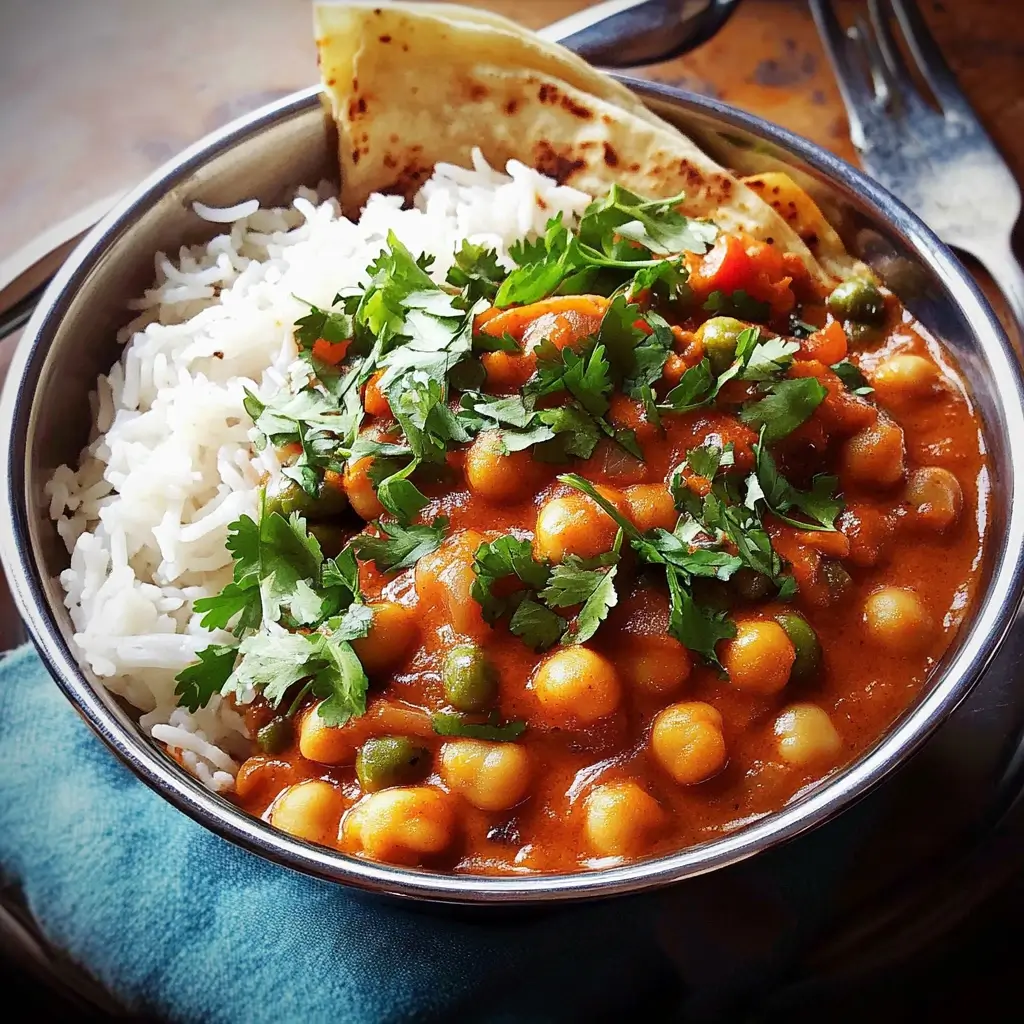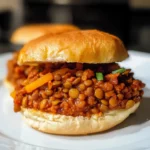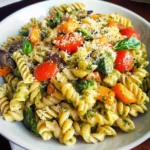The aroma alone was enough to convert my entire family. I remember the first time I decided to try making a vegetarian version of the beloved Tikka Masala, opting for humble chickpeas as the star. There was a healthy dose of skepticism, especially from my husband, who is a die-hard fan of the traditional chicken version. But as the fragrant spices – ginger, garlic, cumin, coriander, and that vibrant garam masala – began to meld with the simmering tomatoes and creamy coconut milk, a hush fell over the kitchen. The kids, usually glued to their screens, wandered in, noses twitching, asking, “What’s that amazing smell?” Dinner that night was a revelation. The chickpeas, tender and satisfying, soaked up the rich, complex sauce beautifully. Even my husband had to admit, with a second helping already on his plate, that this Chickpea Tikka Masala was “surprisingly incredible.” It wasn’t just a substitute; it was a standout dish in its own right. Since then, it’s become a regular in our meal rotation – a testament to its deliciousness, its comforting warmth, and the surprising ease with which it comes together. It’s the kind of meal that feels like a warm hug, perfect for a cozy night in, yet impressive enough to serve to guests. We’ve found it’s not just a hit with vegetarians; even our most devoted meat-eaters ask for it. It’s proof that plant-based eating can be incredibly flavorful, deeply satisfying, and an absolute joy to cook and share. This recipe is more than just food; it’s a creator of happy memories and full bellies around our table.
Ingredients
Here’s what you’ll need to create this delightful Chickpea Tikka Masala:
- For the Chickpeas & Marinade (Optional but Recommended):
- 2 (15-ounce) cans chickpeas (garbanzo beans): Rinsed and drained. These are the hearty, protein-packed stars of our dish.
- 1 tablespoon lemon juice: Freshly squeezed adds a bright tang.
- 1 teaspoon ground cumin: For earthy warmth.
- 1 teaspoon ground coriander: Adds a citrusy, floral note.
- ½ teaspoon turmeric powder: For color and a mild, peppery flavor.
- ½ teaspoon salt: To season the chickpeas from within.
- 1 tablespoon olive oil or neutral cooking oil: To help the spices coat the chickpeas.
- For the Tikka Masala Sauce:
- 2 tablespoons olive oil or coconut oil: The base for sautéing our aromatics. Coconut oil can add a subtle sweetness.
- 1 large yellow onion: Finely chopped, forms the sweet and savory base of the sauce.
- 3-4 cloves garlic: Minced or finely grated, for that essential pungent kick.
- 1-inch piece of fresh ginger: Peeled and minced or finely grated, adds a warming, zesty spice.
- 1 green bell pepper (optional): Chopped, for added texture and a slight bitterness that balances the sweetness. You can also use red or yellow bell pepper.
- 1 jalapeño or serrano pepper (optional): Minced, for those who like a bit of heat. Remove seeds for less spice.
- 1 tablespoon ground cumin: More earthy depth for the sauce.
- 1 tablespoon ground coriander: Reinforcing those bright, citrusy notes.
- 1 teaspoon turmeric powder: For that beautiful golden hue and anti-inflammatory benefits.
- 1 teaspoon garam masala: A complex spice blend that is key to Tikka Masala flavor; add it towards the end for best results.
- ½ – 1 teaspoon Kashmiri red chili powder (or paprika for mildness): Provides vibrant color and mild heat. Adjust to your spice preference.
- 1 (28-ounce) can crushed tomatoes or tomato purée: The acidic, fruity backbone of the sauce. Crushed tomatoes offer more texture.
- 1 (13.5-ounce) can full-fat coconut milk: This is crucial for the signature creaminess of the Tikka Masala. Shake well before opening.
- 1 tablespoon tomato paste: For concentrated tomato flavor and a richer color.
- 1 teaspoon sugar (or maple syrup for vegan): Balances the acidity of the tomatoes. Adjust to taste.
- Salt to taste: Essential for bringing all the flavors together.
- Fresh cilantro (coriander leaves): Chopped, for garnish and a burst of freshness.
- Lemon or lime wedges: For serving, to brighten the flavors.
Instructions
Follow these steps to create a mouthwatering Chickpea Tikka Masala:
- Prepare the Chickpeas (Optional Marination): If you have time, this step adds extra flavor. In a medium bowl, combine the rinsed and drained chickpeas, lemon juice, 1 teaspoon cumin, 1 teaspoon coriander, ½ teaspoon turmeric, ½ teaspoon salt, and 1 tablespoon olive oil. Toss gently to coat. Set aside for at least 15-20 minutes, or while you prepare the sauce ingredients. If you’re short on time, you can skip this marination and add the chickpeas directly to the sauce later.
- Sauté Aromatics: Heat 2 tablespoons of olive oil or coconut oil in a large, heavy-bottomed pot or Dutch oven over medium heat. Once the oil is shimmering, add the finely chopped onion. Sauté for 5-7 minutes, or until softened and translucent, stirring occasionally.
- Add Ginger, Garlic, and Peppers: Add the minced garlic, grated ginger, and optional chopped green bell pepper and minced jalapeño (if using) to the pot. Sauté for another 2-3 minutes, until fragrant. Be careful not to burn the garlic.
- Bloom the Spices: Add the 1 tablespoon ground cumin, 1 tablespoon ground coriander, 1 teaspoon turmeric powder, and ½ – 1 teaspoon Kashmiri red chili powder (or paprika) to the pot. Stir constantly for about 1 minute until the spices are fragrant and well combined with the onion mixture. This step, known as “blooming,” intensifies the flavor of the spices.
- Build the Tomato Base: Stir in the tomato paste and cook for another minute, stirring frequently, to deepen its flavor. Then, add the crushed tomatoes (or tomato purée). Bring the mixture to a gentle simmer.
- Simmer the Sauce: Reduce the heat to low, cover the pot, and let the sauce simmer for 10-15 minutes. This allows the flavors to meld and the sauce to thicken slightly. Stir occasionally to prevent sticking.
- Add Chickpeas and Coconut Milk: Stir the (marinated or plain) chickpeas into the tomato sauce. Pour in the full-fat coconut milk and the sugar (or maple syrup). Stir well to combine everything.
- Incorporate Garam Masala: Bring the curry back to a gentle simmer. Stir in the 1 teaspoon of garam masala. This spice blend is often added towards the end of cooking to preserve its aromatic qualities.
- Final Simmer & Adjust Seasoning: Let the Chickpea Tikka Masala simmer uncovered on low heat for another 10-15 minutes, or until the sauce has reached your desired consistency and the chickpeas are heated through. Taste the sauce and adjust seasoning as needed – you might want to add more salt, a pinch more sugar to balance acidity, or a bit more chili powder for heat. If the sauce is too thick, you can add a splash of water or vegetable broth. If it’s too thin, let it simmer for a few more minutes uncovered.
- Rest and Serve: Turn off the heat. For best flavor, let the Tikka Masala rest for 5-10 minutes before serving. This allows the flavors to marry even further. Garnish generously with freshly chopped cilantro. Serve hot with your favorite accompaniments.
Nutrition Facts
- Servings: This recipe yields approximately 4-6 servings.
- Calories per serving (approximate, based on 6 servings): Around 400-450 kcal.
- Protein (approx. 12-15g per serving): Primarily from the chickpeas, essential for muscle repair and satiety. This dish is a fantastic source of plant-based protein.
- Fiber (approx. 10-14g per serving): High in dietary fiber from chickpeas and vegetables, promoting digestive health and helping you feel fuller for longer.
- Healthy Fats (approx. 20-25g per serving): Mainly from the coconut milk and olive/coconut oil, providing energy and supporting nutrient absorption. The type of fat in coconut milk is primarily medium-chain triglycerides (MCTs), which are metabolized differently.
- Iron (Varies): Chickpeas are a good source of iron, crucial for oxygen transport in the blood. Pairing with vitamin C-rich tomatoes enhances iron absorption.
- Complex Carbohydrates (approx. 40-50g per serving): From chickpeas and vegetables, providing sustained energy release.
Disclaimer: Nutritional information is an estimate and can vary based on specific ingredients used, portion sizes, and preparation methods.
Preparation Time
- Preparation Time (Chopping & Marinating): 20-25 minutes (includes optional chickpea marination time). If you skip marination and use pre-minced ginger/garlic, this can be reduced to 10-15 minutes.
- Cooking Time: 40-50 minutes (includes simmering time for the sauce and the final curry).
- Total Time: Approximately 1 hour to 1 hour 15 minutes.
This Chickpea Tikka Masala is a relatively quick and straightforward dish, making it perfect for a weeknight meal that feels special, or a relaxed weekend cooking session. The active cooking time is manageable, with much of the duration being hands-off simmering.
How to Serve
Chickpea Tikka Masala is wonderfully versatile and can be served in numerous delightful ways. Here are some popular and delicious options:
- Classic Pairings:
- Steamed Basmati Rice: The fluffy, fragrant grains are perfect for soaking up the rich, creamy sauce.
- Naan Bread: Warm, soft naan (garlic naan is especially good!) is ideal for scooping up every last bit of the masala.
- Roti or Chapati: Whole wheat flatbreads offer a healthier alternative to naan and are equally delicious.
- Jeera Rice (Cumin Rice): Rice flavored with cumin seeds adds another layer of aromatic complexity.
- Garnishes for Extra Flair:
- Fresh Cilantro (Coriander Leaves): A generous sprinkle of chopped cilantro adds a burst of freshness and vibrant color.
- A Dollop of Plain Yogurt or Coconut Yogurt: A swirl of plain dairy yogurt (or coconut yogurt for a vegan option) can add a cooling tang and extra creaminess.
- Lemon or Lime Wedges: A squeeze of fresh citrus juice right before eating brightens all the flavors.
- Thinly Sliced Red Onion or Pickled Onions: Adds a sharp, pungent crunch.
- A Drizzle of Coconut Cream: For an even richer presentation and taste.
- Toasted Flaked Almonds or Cashews: For a delightful nutty crunch.
- Side Dishes to Complete the Meal:
- Simple Kachumber Salad: A refreshing Indian salad made with chopped cucumber, tomatoes, onions, and a lemon-cilantro dressing.
- Raita: A cooling yogurt-based side dish, often with cucumber, mint, or boondi (crispy chickpea flour droplets).
- Steamed or Roasted Vegetables: Such as green beans, broccoli, or cauliflower, lightly seasoned.
- Mango Chutney or Lime Pickle: For a sweet, spicy, and tangy counterpoint.
- Creative Serving Ideas:
- In a Bowl with Quinoa: For a healthier, protein-rich grain alternative.
- As a Filling for Wraps or Pittas: With some fresh lettuce and a drizzle of yogurt.
- Over Baked Potatoes or Sweet Potatoes: For a hearty and comforting meal.
No matter how you choose to serve it, this Chickpea Tikka Masala is sure to be a crowd-pleaser!
Additional Tips
To elevate your Chickpea Tikka Masala from great to absolutely sensational, consider these expert tips:
- Toast Whole Spices (If Using): If you have whole cumin and coriander seeds, lightly toast them in a dry pan until fragrant before grinding. This unlocks a much deeper, more complex flavor than pre-ground spices alone.
- Don’t Rush the Onions: Take your time sautéing the onions until they are truly soft and translucent, even slightly golden. This builds a crucial sweet and savory flavor base for your sauce. Rushing this step can result in a less flavorful curry.
- Fresh Ginger and Garlic Always Wins: While pre-minced ginger and garlic are convenient, using freshly minced or grated ginger and garlic will impart a significantly brighter and more potent flavor to your Tikka Masala.
- Adjust Spice Levels Wisely: Kashmiri red chili powder is excellent for color and mild heat. For more significant heat, add a pinch of cayenne pepper or use fresh hot chilies like serrano or bird’s eye, adjusting the amount to your preference. Always taste and adjust.
- Full-Fat Coconut Milk is Key: For the creamiest, richest sauce, use full-fat coconut milk. Light coconut milk can result in a thinner, less satisfying sauce. Shake the can well before opening as the cream often separates.
- Allow Flavors to Meld: Like many curries, Chickpea Tikka Masala often tastes even better the next day after the flavors have had more time to meld and deepen. So, don’t be afraid to make it ahead!
- Deglaze the Pan: After sautéing the aromatics and spices, if there are any browned bits stuck to the bottom of the pot (fond), add a tiny splash of water or vegetable broth and scrape them up. These bits are packed with flavor.
- Don’t Overcook the Chickpeas: Canned chickpeas are already cooked. You’re essentially just heating them through and allowing them to absorb the sauce’s flavors. Overcooking can make them mushy. Add them towards the later stages of cooking the sauce.
FAQ Section
Here are answers to some frequently asked questions about making Chickpea Tikka Masala:
- Q: Is this Chickpea Tikka Masala recipe vegan?
A: Yes, as written, this recipe is entirely vegan if you use olive oil or coconut oil (instead of ghee, which is sometimes used in traditional Tikka Masala) and opt for sugar or maple syrup (instead of honey). Coconut milk provides the creaminess typically achieved with dairy cream. - Q: Is this recipe gluten-free?
A: Yes, the Chickpea Tikka Masala itself is naturally gluten-free. Just ensure you serve it with gluten-free accompaniments like rice, quinoa, or gluten-free naan/bread. Always double-check that your packaged spices (like garam masala) are certified gluten-free if you have celiac disease, as some can have anti-caking agents containing gluten. - Q: Can I use dried chickpeas instead of canned?
A: Absolutely! You’ll need to soak about 1 cup of dried chickpeas overnight and then cook them until tender before adding them to the sauce. This typically yields about 3 cups of cooked chickpeas, which is roughly equivalent to two 15-ounce cans. Cooking from dried can offer a superior texture. - Q: How can I adjust the spiciness of the Tikka Masala?
A: To make it spicier, increase the amount of Kashmiri red chili powder, add a pinch of cayenne pepper, or include more fresh jalapeño/serrano pepper (with seeds for extra heat). For a milder version, reduce or omit the chili powder and fresh chilies, and ensure your garam masala isn’t overly spicy. Paprika can be used for color without much heat. - Q: My sauce isn’t as thick or creamy as I’d like. What can I do?
A: Ensure you’re using full-fat coconut milk. If it’s still too thin, you can let it simmer uncovered for a bit longer to allow some liquid to evaporate. Alternatively, you can make a slurry by mixing 1 tablespoon of cornstarch or arrowroot powder with 2 tablespoons of cold water and stirring it into the simmering sauce until it thickens. You can also blend a small portion (about 1 cup) of the curry and return it to the pot for added creaminess. - Q: Can I add other vegetables to this Chickpea Tikka Masala?
A: Yes, definitely! This recipe is very adaptable. Good additions include spinach or kale (stirred in at the end until wilted), peas (fresh or frozen), cauliflower florets, diced potatoes, or sweet potatoes (add these earlier with the tomatoes so they have time to cook through). - Q: How long can I store leftovers, and can I freeze it?
A: Leftover Chickpea Tikka Masala can be stored in an airtight container in the refrigerator for 3-4 days. It also freezes beautifully! Allow it to cool completely, then transfer to freezer-safe containers and freeze for up to 2-3 months. Thaw overnight in the refrigerator and reheat gently on the stovetop or in the microwave. The texture might be slightly different after freezing due to the coconut milk, but it will still be delicious. - Q: What if I don’t have all the individual spices? Can I use a pre-made curry powder?
A: While using individual spices gives you more control over the flavor profile, you can use a good quality Tikka Masala paste or a robust curry powder as a base if you’re missing many individual spices. You might need to adjust quantities and still add fresh ginger, garlic, and garam masala towards the end for the best flavor. Taste and adjust seasonings as you go.






